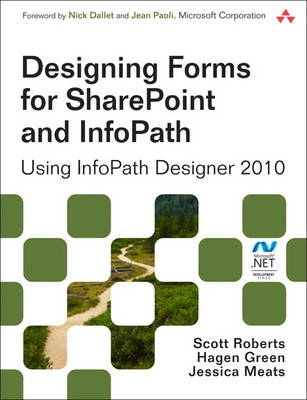
Designing Forms for SharePoint and InfoPath
Addison-Wesley Educational Publishers Inc (Verlag)
978-0-321-74360-2 (ISBN)
- Titel ist leider vergriffen;
keine Neuauflage - Artikel merken
Designing Forms for SharePoint and InfoPath
combines deep knowledge of InfoPath, new insights into SharePoint development, and an insider’s view of new InfoPath features for building more powerful SharePoint applications. Ideal for information workers, power users, and experienced form designers and developers, this book teaches new techniques through downloadable examples, including form templates, code, and XML.
You’ll start with a complete hands-on primer for designing rich forms with InfoPath Designer, covering Forms Services, data retrieval and submission, controls, customization, saving, publishing, and workflow. Next, you’ll turn to advanced form design, including coding, the InfoPath object model, and InfoPath hosting options.
Coverage includes
Mastering best practices for designing forms and working with data
Creating and editing SharePoint list forms in InfoPath 2010
Setting up Forms Services in SharePoint 2010
Using new InfoPath controls and customization techniques
Adding logic without code via Quick Rules and the Rules Management pane
Using the InfoPath Form Web Part to create powerful solutions with minimal code, including data mashups
Submitting, saving, and publishing, including Quick Publish
Building reusable components, custom controls, and add-ins
Securing and efficiently deploying solutions
Making the most of reporting and workflows
Writing better InfoPath code more quickly with Visual Studio Tools for Office
Using import/export and the new import wizard
Customizing forms for creating, viewing, and editing SharePoint lists
Building dynamic queries to REST Web services
Scott Roberts is a Principal Development Lead in the SQL Server group at Microsoft Corporation. Previously, he was a Development Lead on the InfoPath team, and was involved with InfoPath since its inception. While in the InfoPath team, he led the development of many features for designing and editing InfoPath forms. Scott is also the author of Programming Microsoft Internet Explorer 5 (Microsoft Press, 1999) and numerous technical articles and publications. Hagen Green is a Senior Program Manager at Microsoft Corporation, working on the Windows Phone Communications team. He previously led the User Experience Platform test team in SharePoint Foundation. He contributed chapters on InfoPath to Visual Studio Tools for Office: Using Visual Basic 2005 with Excel, Word, Outlook, and InfoPath (Addison-Wesley, 2006), and Visual Studio Tools for Office: Using C# with Excel, Word, Outlook, and InfoPath (Addison-Wesley, 2005). Jessica Meats is a Partner Technology Advisor for Microsoft Corporation specializing in Microsoft SharePoint Server, Office and Business Intelligence. She joined Microsoft in 2008, straight out of university, as a Partner Technology Specialist and chose InfoPath as one of her specialities, wishing that some of the companies she’d done temp work for as a student had used such a product. Her job involves helping partner organizations work with these products and aiding new partners quickly gain the skills needed to build a practice around delivering these solutions. Jessica is the author of a science-fiction thriller, Child of the Hive (Book Guild Publishing Ltd., 2009). In her spare time, Jessica writes fiction, juggles fire, and studies kung fu.
Figures xxi
Tables xlv
Foreword xlix
Preface liii
Acknowledgments lxi
About the Authors lxiii
PART I: Designing Forms 1
Chapter 1: Introduction to InfoPath 2010 3
What Is InfoPath? 3
InfoPath 2003 7
InfoPath 2003 Service Pack 1 12
InfoPath 2007 17
InfoPath 2010 22
What’s Next? 25
Chapter 2: Basics of InfoPath Form Design 27
Getting Started 27
What Is a Form Template Anyway? 28
Creating a New Blank Form Template 33
Designing the Layout of Your Form 35
What’s Next? 77
Chapter 3: Introducing Forms Services 79
Getting Started 79
What Is InfoPath in the Browser? 80
Getting Familiar with Browser Forms 85
Designing a Browser-Enabled Form Template 95
Getting Familiar with the Browser Form Experience 105
What’s Next? 108
Chapter 4: Working with Data 111
Getting Started 111
Data Binding 112
Data Source Field and Group Properties 121
Manually Editing the Data Source 145
Advanced Data Binding 167
Editing Default Template Data 180
What’s Next? 183
Chapter 5: Advanced Controls and Customization 185
Getting Started 185
Advanced Controls 186
Control Properties 204
Advanced Customizations 238
What’s Next? 246
Chapter 6: Adding Logic without Code 247
Getting Started 247
Data Validation 247
Conditional Formatting 258
Action Rules 264
Rule Inspector 272
Creating Multiple Views 276
What’s Next? 278
Chapter 7: Retrieving Data from External Sources 281
Getting Started 281
Data Connections 282
SharePoint Libraries and Lists 286
XML Files 290
Databases 301
SOAP Web Services 317
Extended Features of Web Services 333
Data Connections in Browser Forms 334
Secondary Data Source Binding 338
Offline Mode Query Support 343
List Box Controls Connected to Secondary Data Sources 348
What’s Next? 358
Chapter 8: Submitting Form Data 361
Getting Started 361
Why Submit? 362
Submitting Forms 367
Submit Options 420
What’s Next? 423
Chapter 9: Saving and Publishing 425
Getting Started 425
Saving and Publishing a Form Template with InfoPath Designer 426
Publishing a Form Template to Forms Services 442
Saving Templates as Exported Source Files 451
Previewing Form Templates 454
What’s Next? 459
Chapter 10: Workflow 461
Getting Started 461
Workflow with Microsoft Office SharePoint Server 2010 462
Using InfoPath Forms with SharePoint Designer 470
User Roles 479
Workflow with InfoPath E-Mail Forms 499
What’s Next? 519
PART II: Advanced Form Design 521
Chapter 11: Security and Deployment 523
Getting Started 523
Introduction to InfoPath Security 525
InfoPath Security Levels 526
Trust and Designer Lockdown 566
Digital Signatures 574
Information Rights Management 607
What’s Next? 618
Chapter 12: Creating Reports 619
Getting Started 619
Merging Forms 620
Printing 652
Exporting Forms 670
What’s Next? 677
Chapter 13: Writing Code in InfoPath 679
Getting Started 679
Writing Code Behind a Form 680
The InfoPath Object Model 691
Programming InfoPath . . . in Action! 739
Form Code 781
What’s Next? 790
Chapter 14: Advanced Forms Services 791
Getting Started 791
Controls and Browser Optimizations 792
Advanced Publishing and Administration 801
Data Connections 842
Hosting the InfoPath Form Control in a Web Browser 864
Performance Tips and Best Design Practices 888
What’s Next? 901
Chapter 15: Non-SharePoint Functionality 903
Getting Started 903
Hosting Scenarios 904
Document Information Panel 905
Creating an InfoPath Host Application 916
Installing and Using ActiveX Controls 950
Building Custom Controls for InfoPath Using ActiveX 960
What’s Next? 962
Chapter 16: Importers and Exporters 963
Getting Started 963
Built-in Form Importers 964
Creating Your Own Form Importers and Exporters 976
What’s Next? 990
Appendices 991
Appendix A: Integration of InfoPath 2010 and SharePoint Server 2010 List Forms 993
Building or Updating a Site 993
Capabilities of InfoPath and SharePoint List Forms 994
Editing SharePoint Lists Forms 998
Building a Mashup Page 1006
Exporting Data to Excel or Access for Simple Reporting 1018
Summary 1019
Appendix B: Further Reading 1021
Chapter 2: Basics of InfoPath Form Design 1021
Chapter 4: Working with Data 1021
Chapter 5: Advanced Controls and Customization 1022
Chapter 7: Retrieving Data from External Sources 1022
Chapter 8: Submitting Form Data 1022
Chapter 9: Saving and Publishing 1023
Chapter 10: Workflow 1023
Chapter 11: Security and Deployment 1023
Chapter 12: Creating Reports 1024
Chapter 13: Writing Code in InfoPath 1024
Chapter 14: Advanced Forms Services 1025
Chapter 15: Non-SharePoint Functionality 1025
General Reference Material 1026
Index 1027
| Erscheint lt. Verlag | 19.5.2011 |
|---|---|
| Verlagsort | New Jersey |
| Sprache | englisch |
| Maße | 179 x 227 mm |
| Gewicht | 1340 g |
| Themenwelt | Informatik ► Office Programme ► Office |
| Mathematik / Informatik ► Informatik ► Programmiersprachen / -werkzeuge | |
| ISBN-10 | 0-321-74360-1 / 0321743601 |
| ISBN-13 | 978-0-321-74360-2 / 9780321743602 |
| Zustand | Neuware |
| Haben Sie eine Frage zum Produkt? |
aus dem Bereich


